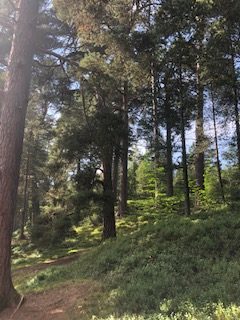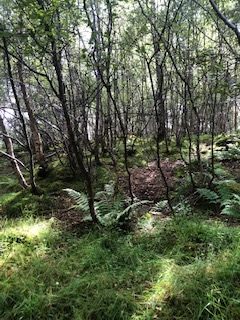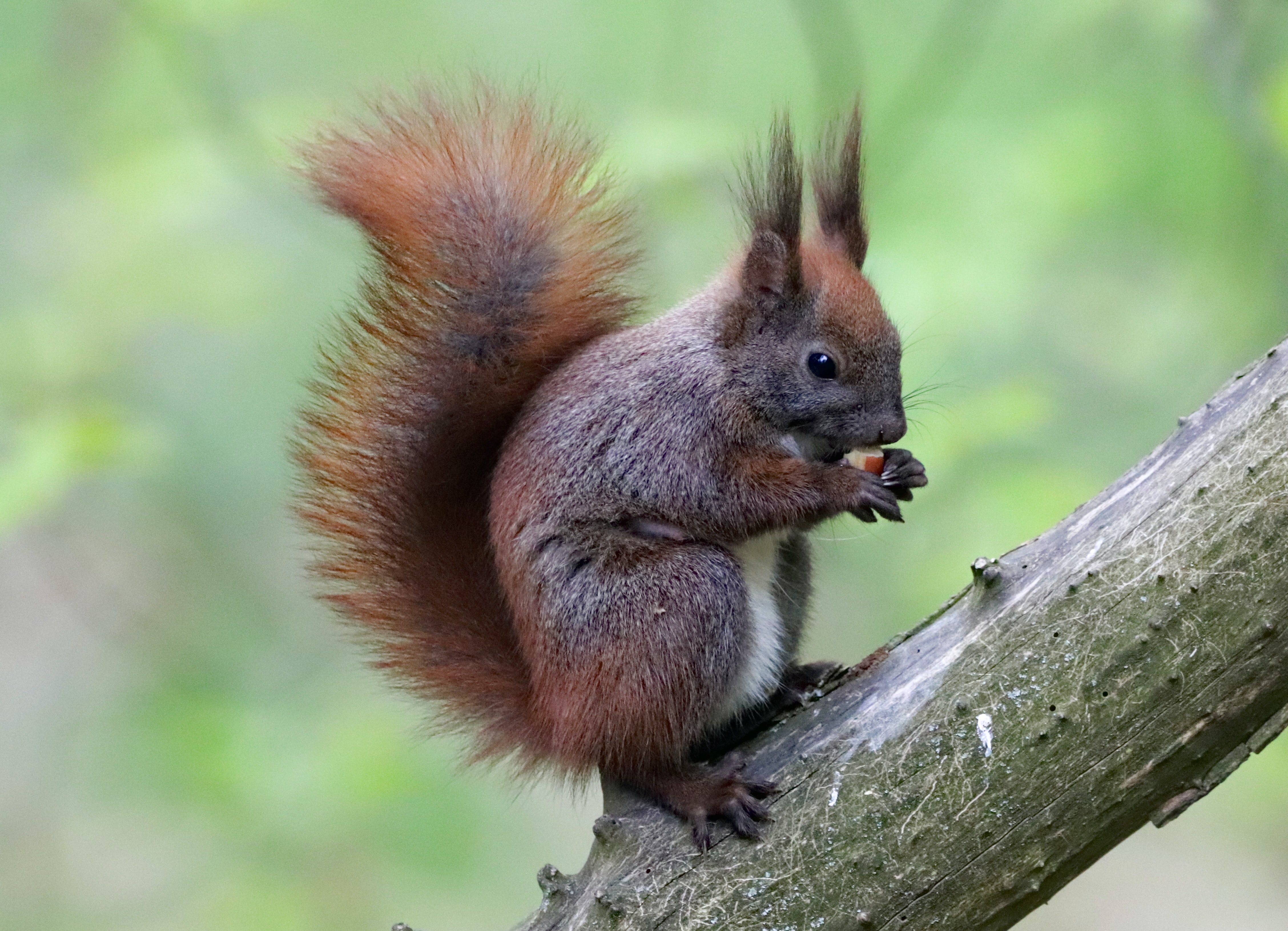Last week you would have found me in the Highlands of Scotland. It is a magical place of ancient woodland; purple, heather-clad mountains and water everywhere. I lost count of the lakes and clear running streams we came across and saw enough mini waterfalls to satiate even my appetite.
While there, we ensured that we filled our days with culture and nature. Often both were intertwined as at the inimitable Clava Cairns. We drove down tiny lanes to discover perfectly preserved Pictish standing stones; saw a ruined cathedral and explored the Highland Folk museum to experience first hand what it would be like to live in a tiny, crofter’s cottage. But the highlight of our trip was without question the ancient woodland that borders where we stayed in Grantown on Spey: the Anagach Woods.
Almost every day, we took a walk (or in my case a scooter) through its other- worldly landscape and it got me thinking about why woods are my happy place and how forests are vital to our well-being.

Woods and the mind
As an archetype, woods represent our inner landscape. To psychologists like Jung, they were seen to embody, metaphorically, the unconscious. They are dark and impenetrable, easy to get lost in and a little dangerous.
When we explore our unconscious – perhaps through therapy or perhaps our own contemplations – we are forced to face our darker thoughts and fears. It is often a rather scary and even unpleasant experience. However, if we can hold our nerve until we are ready to return, it is an exceptionally enriching one.
Just as Hansel and Gretel and Snow White must face the dangers of the forest to return mature and triumphant, so too must we find courage and cunning to negotiate our world. Wandering through real woods inspires contemplation in a peaceful cathedral of trees. It unites mind, body and spirit without the price tag of an expensive spa day.
Forest bathing
Many of us are familiar with the Japanese concept of forest bathing. In Japan it is called shinrin-yoku, which translates as ‘making contact with and taking in the atmosphere of the forest’. What I did not know was that it was an idea promoted by the Japanese government from the 1980s to improve its citizens’ health. Researchers had discovered that meditative immersion in the woods had significant health benefits – lowering blood pressure and stress while simultaneously heightening cognitive abilities – particularly concentration and memory.
As a further bonus, they discovered that trees release chemicals which had a positive effect on the human immune system. If you would like to learn more about forest bathing, I would head to the source I used. It has a handy guide to how to make the best of your woodland adventures, too. https://www.nationaltrust.org.uk/lists/a-beginners-guide-to-forest-bathing

An abundance of flora
From a distance, woodland can seem a little monotonous – tree after tree with very few hues other than shades of green and brown. But if we enter into the wood, alert to all it has to offer, we are rewarded with an abundance of plants and colour.
This year has been especially wet in Scotland, as well as most of the UK. As a result, fungi have been having a particularly good year. I have never seen such a variety of mushrooms from the fairy like red spotted to the tiny purple ones. Equally abundant were the tiny flowers that skirted the tracks where there was a little more light than the interior.
Planted in 1765, this pine forest is unusually old. Some of the trees are so tall that only craning your neck skyward allows you to see the tops. As is usually the case in nature, the pine were not going to have all the place to themselves. There were plenty others: rowan trees heavy with berries; willows by the water and birch and beech taking up what ground they could.
The undergrowth was thick with moss and ferns and some of the of the old trees were festooned with strands of hanging moss similar to the Spanish moss you find in the southern states of America.
But perhaps most prolific of all were the wild blaeberries – a kind of blue berry that was laden with fruit. The berry was more bitter than the commercial blueberry, but tasty all the same. We even found some wild raspberries. It was a forager’s paradise.




Sensual pleasures
In addition to the delicious treats we found on the trail, all our other senses were satisfied too. There are few places more quiet than forest and this silence is a real balm after the hubbub of modern life. After a while, the peace is broken by bird song or simply the sound of one’s own footfall. These noises provide no irritation, however, only a counterpoint to the stillness.
Hardly any scents are more refreshing than that of fresh pine and the air was full of it. Even the slightly damper, earthy smell of the ground and leaf matter was pleasant, reminding me of days exploring the woods near my childhood home. They were not expansive, but full of mystery and adventure to a ten-year-old child.
Touch was satisfied not by the jolting journey via scooter but by the exquisite velvet of the mosses and the prickly delightfulness of pine cones. The ground cover was lush and soft with pine needles and moss. I could think of worse places to make my bed.
Of sights, there were too many to tell, but our favourites included the wild animals that peeked shyly from the foliage.
Animal magic
The Highland woods are home to several elusive creatures: the red squirrel, the roe deer, the endangered capercaillie (bird) and the pine marten. We were lucky enough to spot three of the four – though the pine marten was crossing the road on the way to Elgin!
Two roe deer fawns were our first encounter. They peeped out from behind some trees and shrubs and seemed as interested in us as we were in them. We watched them for as long as we could before Hermione realised there was anything to see. We had no desire to frighten them.
The red squirrel, that I had only seen in captivity before, eluded us until almost our last day. Coming across a group of people looking up, we did too. And there he was scampering at astonishing speed between the trees. Later on, I found my own squirrel who was rather more still and we admired him for a long time. It was one of those rare moments in life when time slows to no-time, as one is held rapt in a capsule of absolute attention.

Living deliberately
Like Thoreau, “I went to the woods because I wished to live deliberately, to front only the essential facts of life, and see if I could not learn what it had to teach, and not, when I came to die, discover that I had not lived.’ (Walden) Woodland has always been precious to me. There is something ancient and elemental about it, something magical. In the woods, the imagination can run free and your are forced – unless you wish to lose your footing or your way – to pay attention to everything around you.
Perhaps it is this slight frisson of danger that makes it thrilling. Perhaps it is being surrounded absolutely by nature’s beauty and mystery that makes it inspiring. Perhaps it is a combination of all these plus childhood memories that make a woodland walk so satisfying. The science tells us it is good for us; I think we already knew.

Sounds blissful! I too love woodland – there is such a soothing energy and something magical about them. Glad you had such a lovely time. And thank you for sharing it!
So glad you enjoyed it and hope you have had a lovely summer too! x